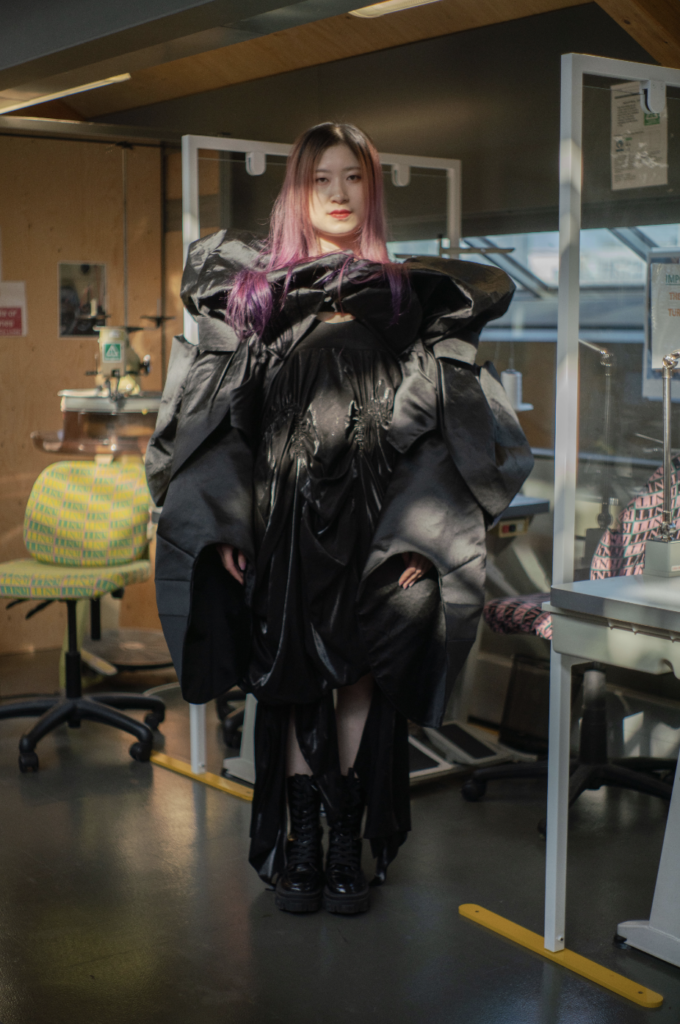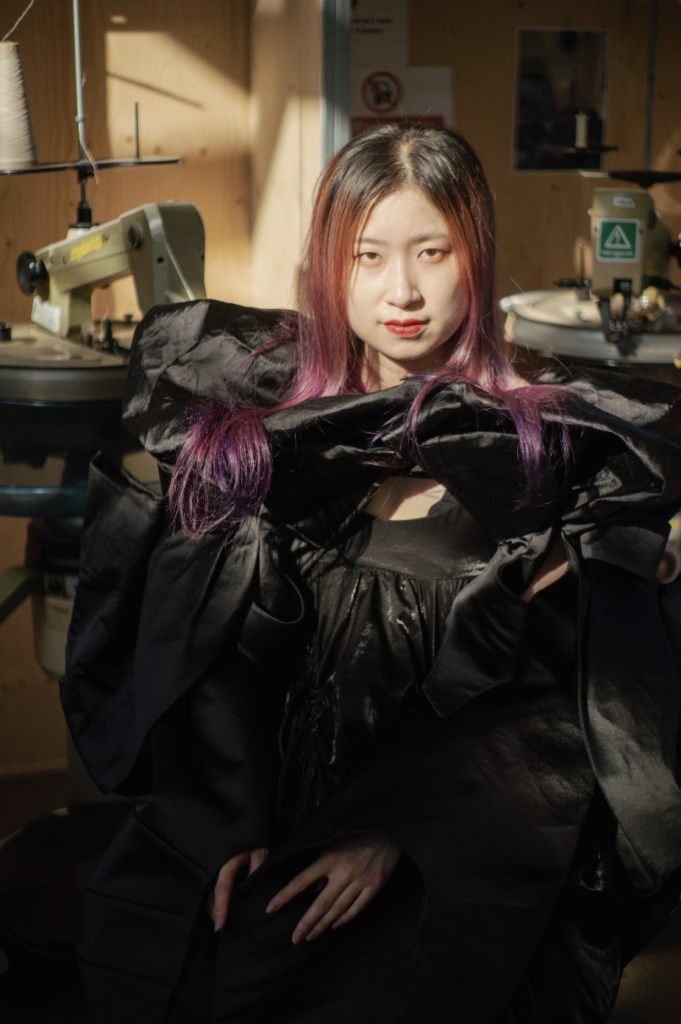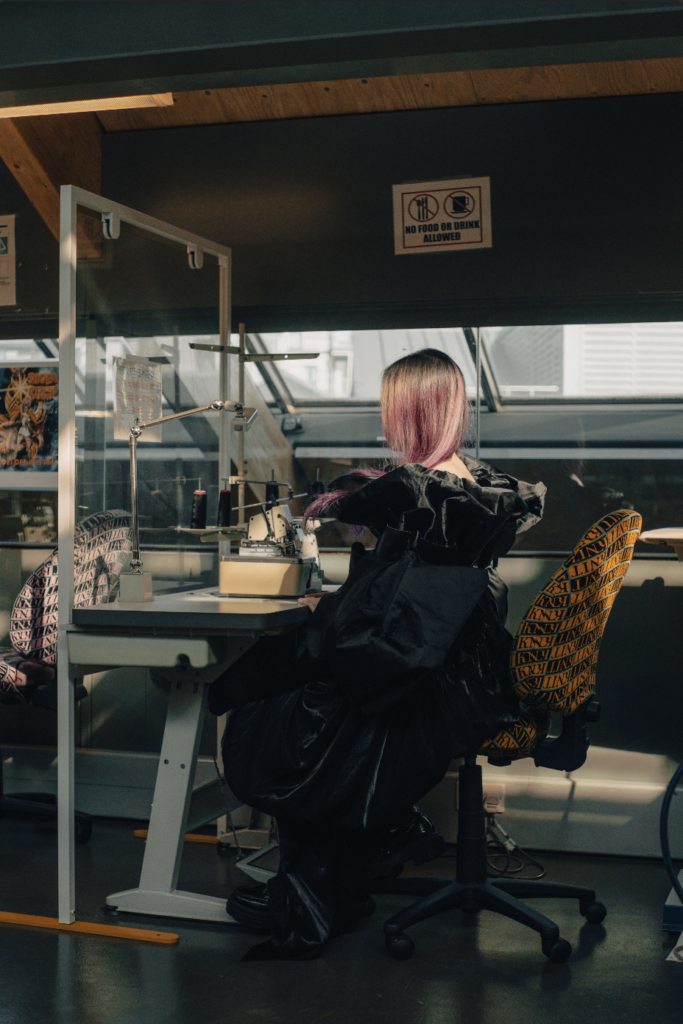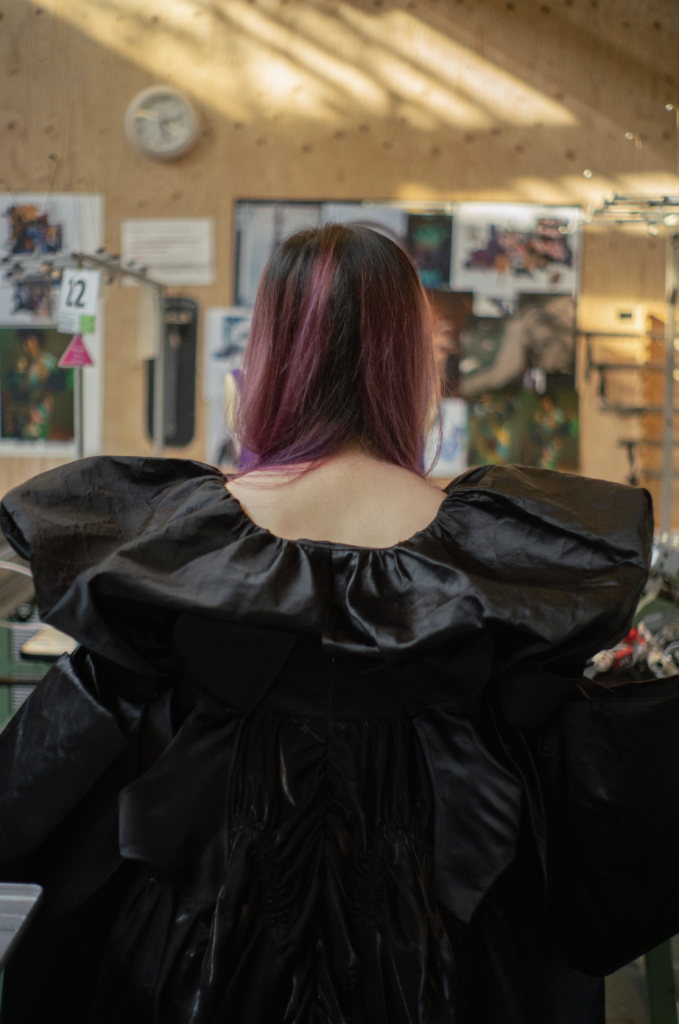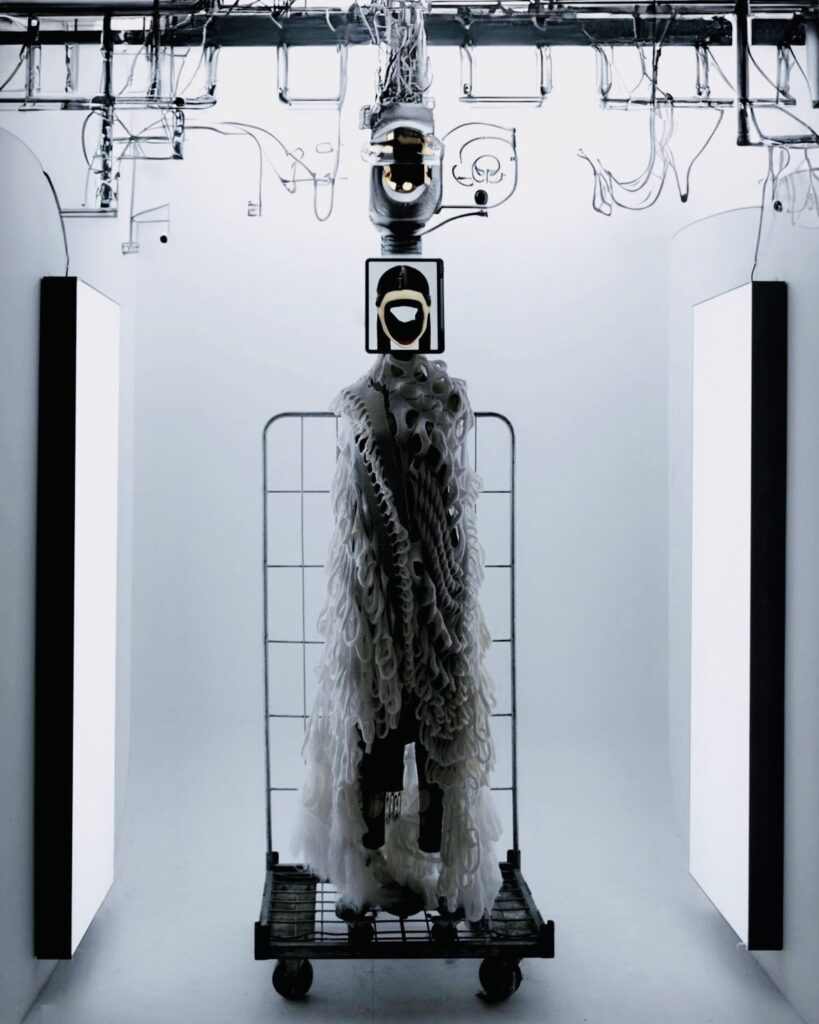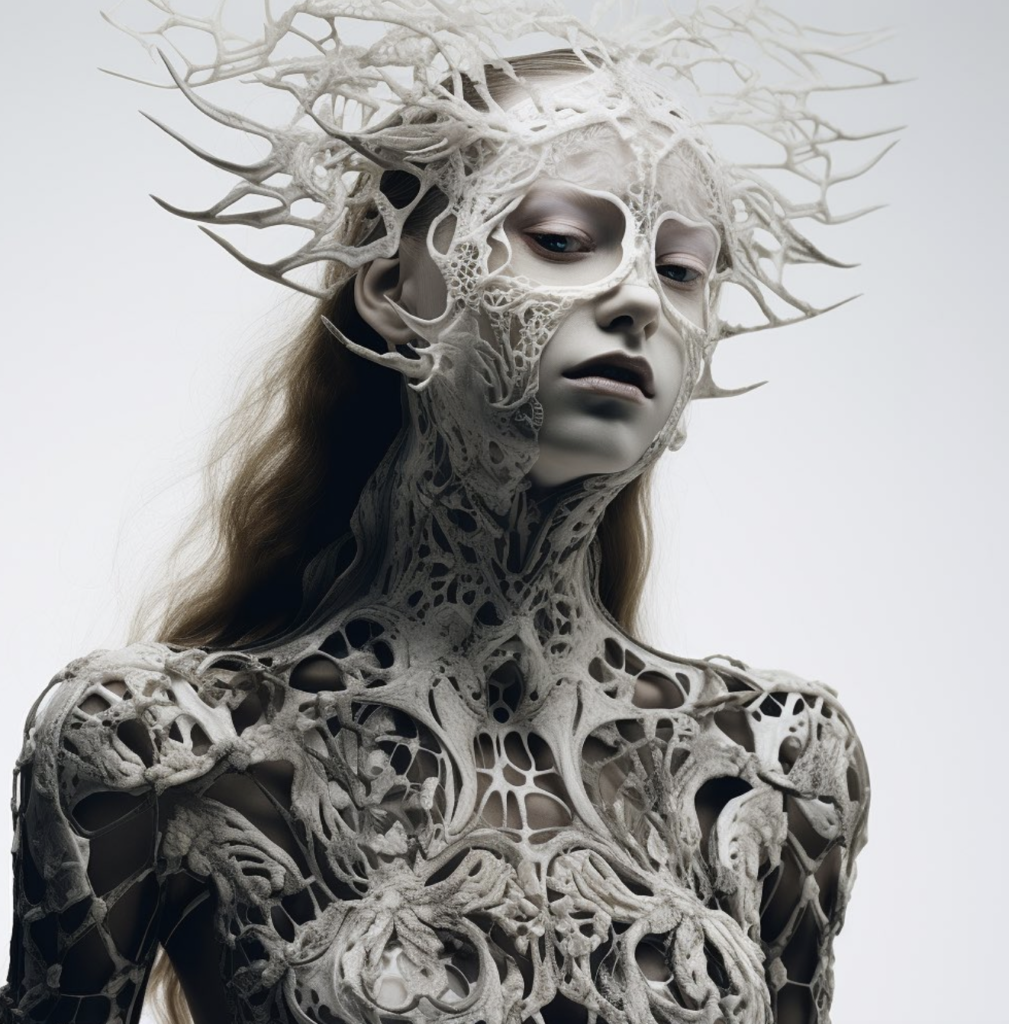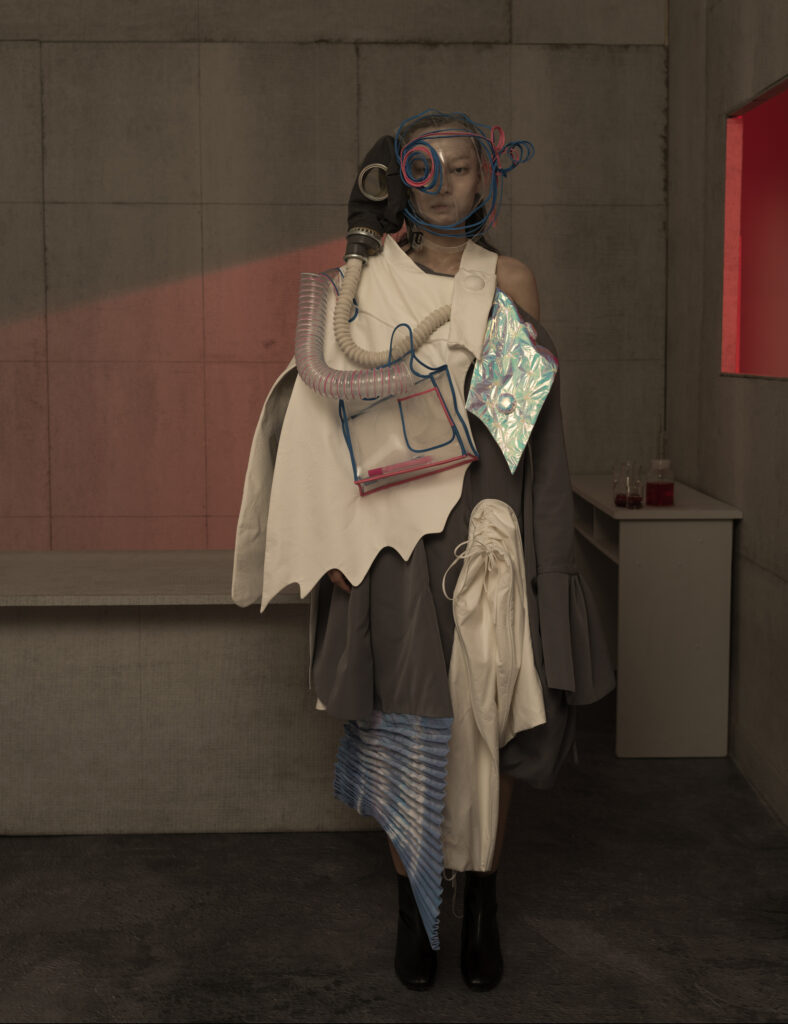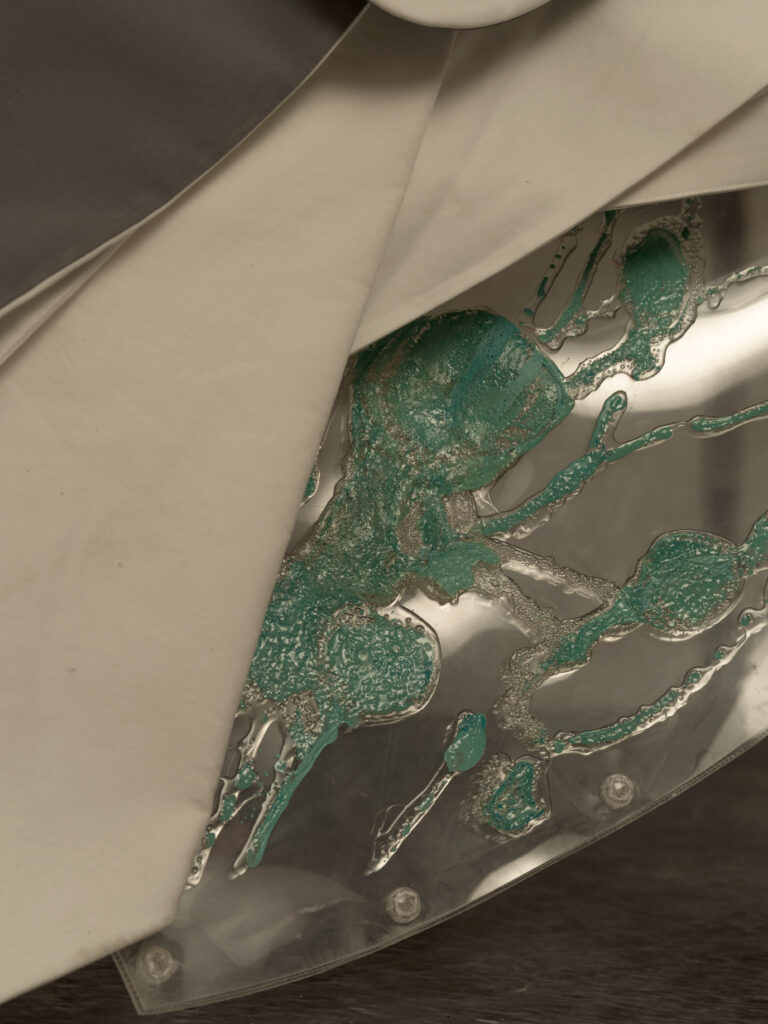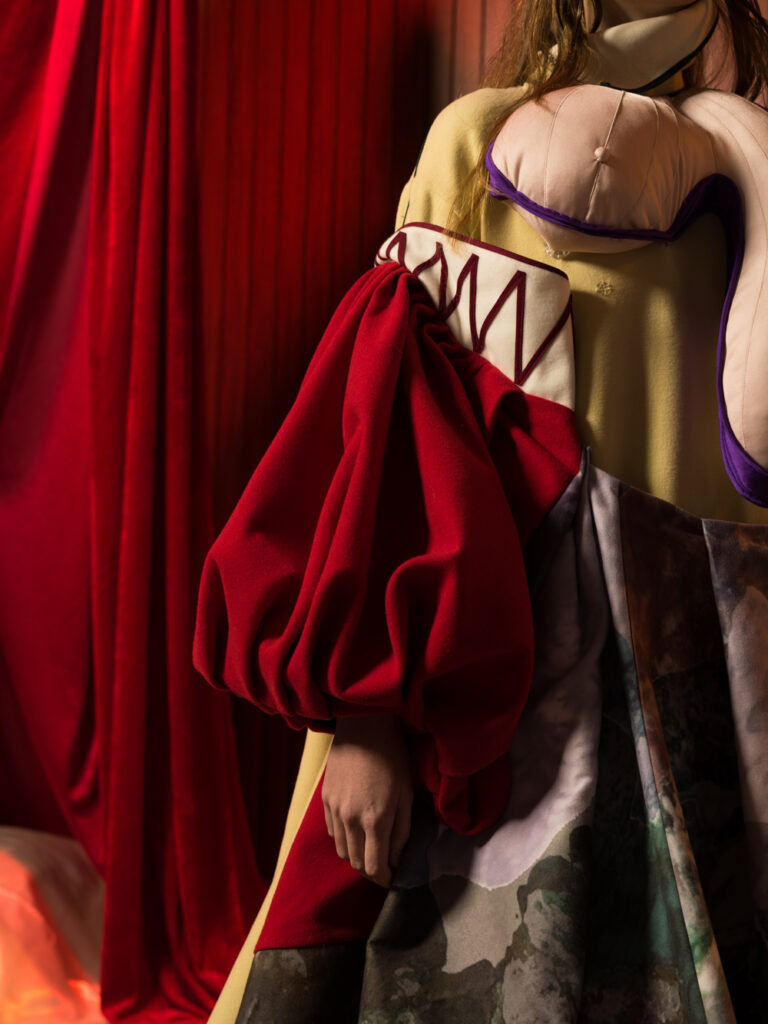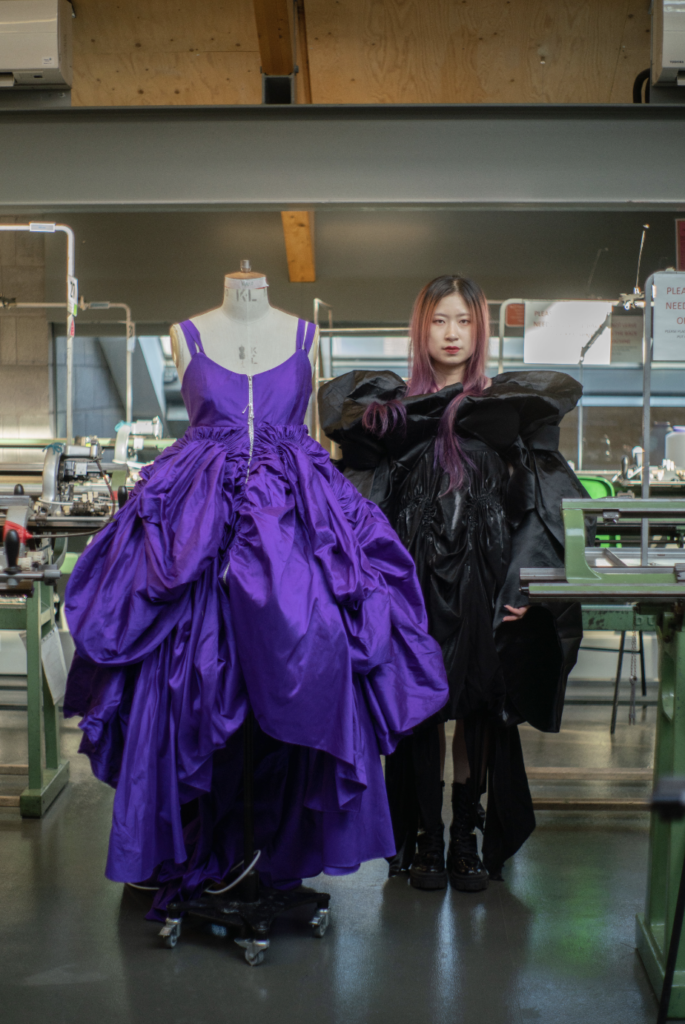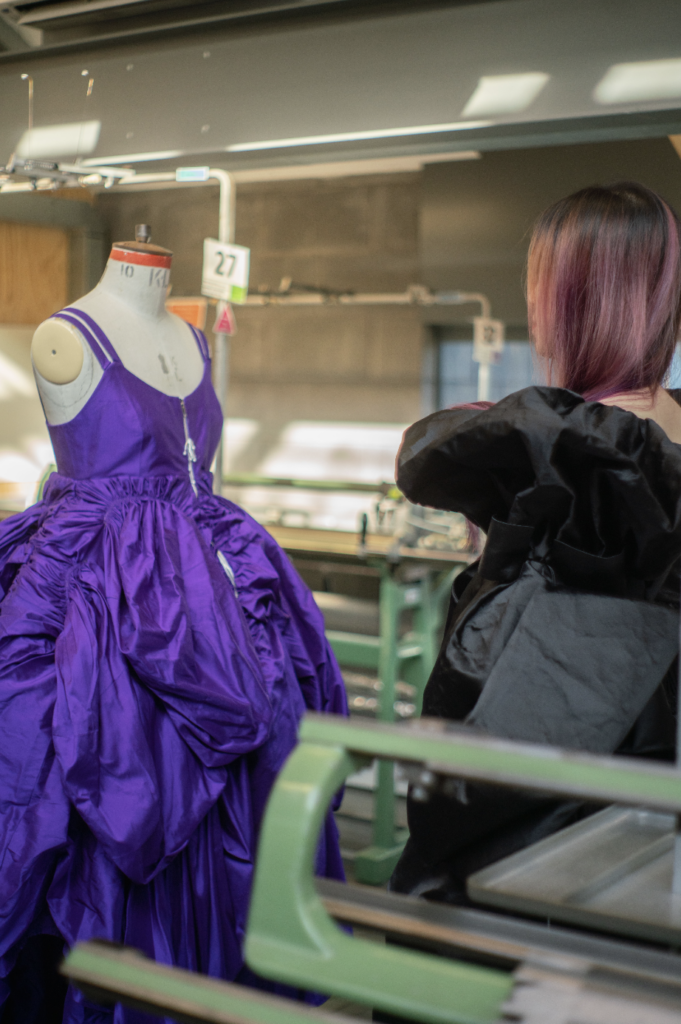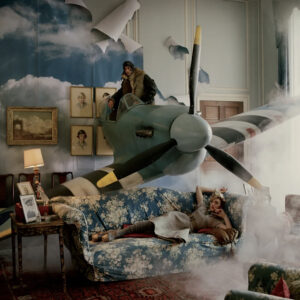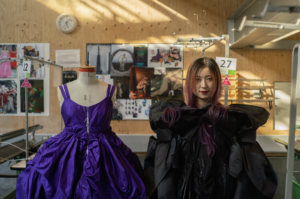Originaria de China, la diseñadora de moda Bingrong Huang, se mudó a Londres para estudiar en el London College of Fashion. A la espera de un futuro cyberpunk atravesado por la moda, diseña vestuarios que se extienden y actuan como prótesis.
Sofía: ¿Podes contarme cómo es normalmente tu proceso creativo cuando estás diseñando una nueva pieza de moda o colección? ¿Qué es lo que más te inspira para crear nuevas ideas de diseño? ¿Hay temas, colores o conceptos específicos que a menudo influyan en tu trabajo?
Bingrong: Normalmente, comienzo con una película o un libro y lo combino con mis experiencias personales. Mis emociones sirven como el catalizador más inspirador; cuando experimento emociones intensas y sentimientos profundos acerca de algo, las ideas fluyen rápidamente. Sí, estoy profundamente comprometida con temas como el surrealismo, la sociedad y la humanidad. Estos conceptos impregnan constantemente mi trabajo, como la esencia de mis creaciones.
Sofía: Can you walk me through your typical creative process when designing a new fashion piece or collection? How do you usually start? What inspires you the most when coming up with new design ideas? Are there specific themes, colors, or concepts that often influence your work?
Bingrong: I usually start with a movie or a book and combine it with my personal life experiences. My emotions serve as the most inspiring catalyst; whenever I experience strong emotions and deep feelings about something, ideas flow quickly. Yes, I am deeply engaged with themes such as surrealism, society, and humanity. These concepts consistently permeate my work, much like the soul of my creations.
S: La colaboración es frecuentemente una parte clave de la industria de la moda. ¿Cómo incorporas comentarios e ideas de otros sin perder la esencia de tu propia visión creativa?
B: Mientras presento mis propias ideas, también priorizo el respeto a las diferencias y mantener discusiones constructivas. Al colaborar con otros colegas que tienen puntos de vista diferentes, mi reacción inicial no es refutar, sino reflexionar sobre por qué podrían tener esas perspectivas. Siempre considero si sus sugerencias podrían ser mejores soluciones o si hay una manera de incorporar lo mejor de ambos mundos.
S: Collaboration is often a key part of the fashion industry. How do you incorporate feedback and ideas from others without losing the essence of your own creative vision?
B: While presenting my own creative ideas, I also prioritize respecting differences and maintaining constructive discussions. When collaborating with other partners who hold different viewpoints, my initial reaction is not to refute, but rather to reflect on why they might hold those perspectives. I consider whether their suggestions could be better solutions or if there’s a way to incorporate the best of both worlds.
S: ¿Qué es lo que más te gusta de estudiar en LCF?
B: La atmósfera general de la escuela es muy destacable. No hay competencia tóxica; todos están trabajando diligentemente hacia sus metas. Si tus compañeros admiran tu trabajo, expresan su aprecio de todo corazón y con gran amabilidad. Las abundantes alabanzas y reconocimientos tanto de profesores como de compañeros me han dado un fuerte sentido de confianza, impulsándome hacia adelante con determinación. La excepcional enseñanza de técnicas de la escuela me permite convertir mis ideas creativas en realidad en lugar de confinarlas al papel.
S: What is the thing you like the most about studying at LCF?
B: The overall atmosphere of the school is remarkable. There is no toxic competition here; everyone is diligently working towards their goals. If classmates admire your work, they express their appreciation wholeheartedly. Every individual is kind-hearted. The abundant praise and recognition from both teachers and peers have instilled a strong sense of confidence in me, propelling me forward with determination. The school’s exceptional teaching of techniques enables me to translate my utmost creative ideas into reality, rather than confining them to paper.

S: Tu trabajo ‘Cursed Spirit’, inspirado en la película animada ‘Jujutsu Kaisen O’, parece abordar el amor y la simbiosis como un tema único. ¿Cómo exploraste este concepto en términos de construcción de prendas, materiales o incluso la presentación de la colección?
B: Percibí esta relación como los bucles entrelazados del tejido de punto, donde cada bucle sostiene firmemente al siguiente, simbolizando su viaje desde ser compañeros de infancia hasta tener sus destinos entrelazados. Usé una estructura de bucle progresivo para ilustrar esta evolución. El tejido de punto incorpora más de seis hilos distintos, cada uno representando una faceta de su conexión. La utilización de hilos más rígidos fue inspirada por la estructura subyacente de la transformación de Rika en un espíritu después de su encuentro con las dificultades.
S: Your work ‘Cursed Spirit’, inspired by the animated film, ‘Jujutsu Kaisen O’, seems to approach to love and symbiosis as a unique theme. How did you explore this concept beyond the visual aspects, possibly in terms of garment construction, materials, or even the presentation of the collection?
B: I perceive their relationship akin to the interlocking loops of knitting, where each loop snugly holds the next, symbolizing their journey from childhood companions to intertwined destinies. I employed a progressive loop structure to illustrate this evolution. The knitting incorporates more than six distinct yarns, each representing a facet of their connection. The utilization of stiffer yarns was inspired by the underlying framework of Rika’s transformation into a spirit after her encounter with hardships.
S: En tu proyecto ‘Cyberpunk and Human Nature’, una pieza parece adaptarse al cuerpo de múltiples maneras, como una prótesis. ¿Cuál fue tu inspiración para esto? ¿Cuáles son tus opiniones sobre la moda desde una perspectiva cyberpunk?
B: Ese proyecto estuvo inspirado en Blade Runner 2049. En la película, la situación en la que los replicantes son esclavizados y tratados brutalmente por los humanos, igualmente mantiene el sentido de justicia y disposición para sacrificarse por sus compañeros. Esto me inspiró a explorar el conflicto entre la forma subyugada de los replicantes y sus almas genuinas utilizando un marco similar.
Desde una perspectiva ciberpunk, espero con ansias un futuro en el que la moda trascienda su papel exclusivamente para los humanos y extienda su servicio a animales, plantas e incluso robots. Al mismo tiempo, percibo una similitud entre el ciberpunk y la moda en su búsqueda compartida de avances e innovación.
S: In your project ‘Cyberpunk and Human Nature’, one piece seems to adapt to the body in multiple ways, as a prosthesis. What was your inspiration for this? What are your views on fashion from a cyberpunk perspective?
B: That is inspired by the film Blade Runner 2049. In the movie, the scenario where the replicants are enslaved and brutally treated by humans, yet maintain their sense of justice and willingness to sacrifice for their companions, inspired me to explore the conflict between the subjugated form of replicants and their genuine souls using a similar framework.
From a cyberpunk perspective, I eagerly anticipate a future where fashion transcends its role solely for humans and extends its service to animals, plants, and even robots. Simultaneously, I perceive a commonality between cyberpunk and fashion in their shared pursuit of breakthroughs and innovation.
S: ¿Podes contarme sobre tus inspiraciones para ‘Chemical Warfare’?
B: Este proyecto derivó de una exposición sobre la guerra química que había visto, en la que me interesé mucho por los cambios que los materiales químicos generaban en el cuerpo humano, y en los trajes protectores y las máscaras de gas usadas para evitar que los gases venenosos invadieran el cuerpo.
‘Chemical Warfare’ consistió en extensos experimentos en la manipulación de tejidos y las alteraciones de la silueta relacionadas con los cambios en la morfología de la piel inducidos por gases químicos.
S: Can you tell me about your inspirations for ´Chemical Warfare´ project?
B: This project derives from an exhibition about chemical warfare that I had seen, at which I was very interested in the changes of chemical materials on the human body, and the protective suits and gas masks worn to prevent poisonous gas from invading the human body.
In the project, extensive experimentation was conducted on fabric manipulation and silhouette alterations related to chemical gas-induced changes in skin morphology.
S: La moda sostenible es una preocupación creciente. ¿Cuáles son tus opiniones sobre la integración de la tecnología para crear diseños o procesos de producción más respetuosos con el medio ambiente? ¿Qué otros caminos crees que son viables para esto?
B: Aprecio mucho este enfoque, es muy importante que la moda sea respetuosa con el medio ambiente. Creo que otras vías pueden explorar el concepto de versatilidad, donde una sola prenda sirva para múltiples propósitos. Por ejemplo, una parte o la totalidad de una prenda podría transformarse en una bolsa, un equipo para exteriores o incluso una carpa.
S: Sustainable fashion is a growing concern. What are your views on integrating technology to create more environmentally friendly designs or production processes? What other paths do you think are fine for this?
B: I highly appreciate this approach, as I believe environmentally-friendly fashion is of utmost importance. I think other avenues can explore the concept of versatility, where a single garment serves multiple purposes. For instance, a part or the entirety of a piece of clothing could transform into a bag, an outdoor gear, or even a tent.
S: Algunos diseñadores están explorando la impresión 3D y textiles inteligentes en sus creaciones. ¿Estás experimentando con estas tecnologías? ¿Cómo influyen en tus posibilidades de diseño?
B: También he estado estudiando y experimentando. La impresión 3D tiene el potencial de aportar avances a los métodos tradicionales de moda y diseño. La manipulación del software permite la creación de formas más intrigantes, liberándose de las limitaciones de los materiales de prendas suaves convencionales.
S: Some designers are exploring 3D printing and smart textiles in their creations. Are you experimenting with these technologies, and if so, how do they enhance your design possibilities?
B: I’ve also been studying and experimenting. 3D printing has the potential to bring breakthroughs to traditional fashion and design methods. The manipulability of software allows for the creation of more intriguing shapes, breaking free from the limitations of conventional soft garment materials.
S: La realidad virtual y aumentada se están utilizando cada vez más en presentaciones de moda y experiencias de compra. ¿Cuál es tu visión sobre la influencia de estas tecnologías en la forma en que los consumidores van a interactuar con la moda en el futuro?
B: Me parece un approach fascinante, que permite a los consumidores percibir el efecto de probarse las prendas, al mismo tiempo que reduce el desgaste de la ropa. Creo que este método se va a volver cada vez más común.
S:Virtual reality (VR) and augmented reality (AR) are increasingly being used in fashion presentations and shopping experiences. How do you see these technologies influencing the way consumers interact with fashion in the future?
B: I find this to be a fascinating approach, enabling consumers to quickly perceive the post-try-on effect while reducing wear and tear on the clothing. In the future, I believe this method will become increasingly prevalent.


